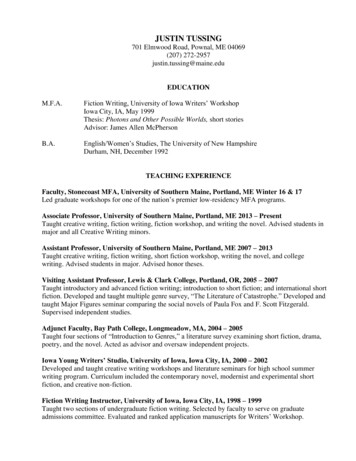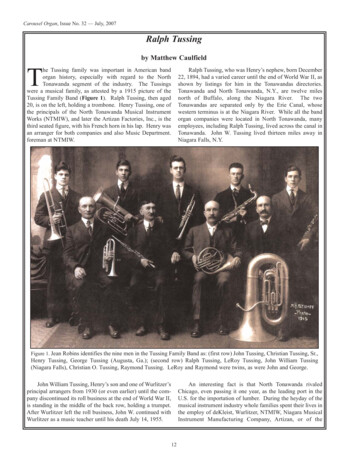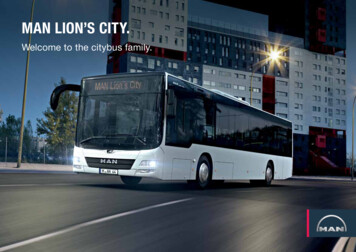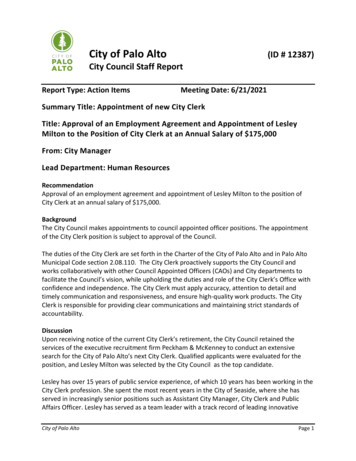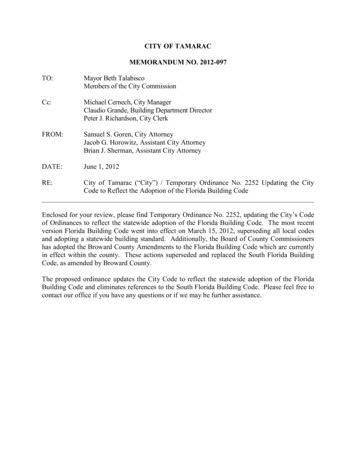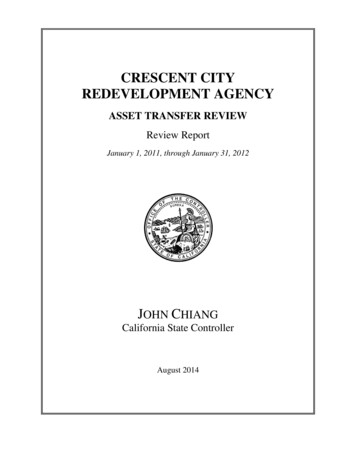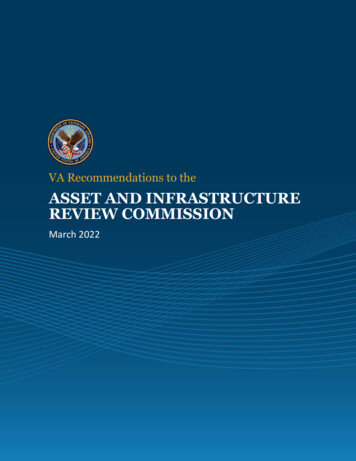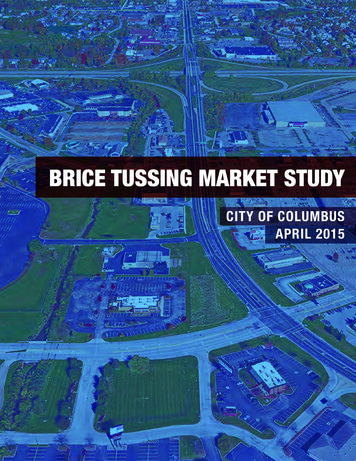
Transcription
BRICE TUSSING MARKET STUDYCITY OF COLUMBUSAPRIL 2015
OVERVIEWBRICE TUSSING MARKET STUDYPURPOSE2The Brice-Tussing real estate market study isintended to serve as a base for developmentof the upcoming Brice – Tussing Area Plan.The objectives of the study are as follows: A complete commercial real estatemarket analysis of the retail, services,office, multifamily residential and lightindustrial/warehousing sectors withinthe study area – existing market andfuture forecasts. An objective and defensible perspectiveof the real estate market anddevelopment potential. Evaluation of the zoning and land usepatterns relative to the market studyfindings.PREPARED BY:
TABLE OF CONTENTS04EXECUTIVE SUMMARY26LAND USE / ZONING ANALYSIS10INTRODUCTION29MARKET GUIDELINES11PREVIOUS AREA STUDIES33NEAR-TERM MARKET OPPORTUNITIES12STUDY/TRADE AREA BACKGROUND44LONG-TERM OPPORTUNITIES15STAKEHOLDER INTERVIEWS45OPPORTUNITY SITES21MARKET INFLUENCES:PHYSICAL ENVIRONMENT52INCENTIVES REVIEW24ROADWAY NETWORK ANALYSISCOLUMBUS PLANNING DIVISION50 W. Gay Street, Fourth FloorColumbus, Ohio, 43215(614) 645-8036For this study and other planning documents,visit: www.columbus.gov
1.0 EXECUTIVE SUMMARYBRICE TUSSING MARKET STUDYFrom its inception, the Brice Road/I-70interchange was poised to be a regionaldistribution, shopping, employment andhospitality center, based on the followingfactors: Prime location as first exit east of I-270/eastern gateway to Columbus. Direct visibility of the area from I-70 forboth regional area residents and out-oftown travelers. Large number of nearby residents. Eventoday, there are more residentsestimated within a ten minute drivetime of Brice Road than theinterchanges at Polaris Parkway,Sawmill Road or Stringtown 00,000300,000200,000100,0000INTERCHANGEPOPULATION WITHIN10-MIN DRIVE TIMEBrice Road/I-70182,744Polaris Parkway/I-71156,474Sawmill Road/I-270163,332Stringtown Road/I-71112,6931970s1980s1990s2000sThe area experienced growth in the 1970swith a few national/regional distributorsand select car dealerships capitalizing onfreeway exposure and access, including: JCPenney Outlet and DistributionCenter; Kobacker Company Key Automotive (former Oldsmobiledealership); Honda East (now LindsayHonda)The 1980s and 1990s brought nearly 2million square feet of retail developmentto the area: Brice Road was the beneficiary ofoverwhelming consumer spendingand had accounted for 60% to 70%of the southeast Columbus region’sadded retail space.POPULATION PROXIMITY COMPARISONSource: ESRI, Incorporated (2014 Estimates)4Brice-Tussing Retail Development by DecadeSquare FeetThe following summarizes key findings andconclusions contained within the marketanalysis. Identifying market potential forthe redevelopment of a once vibrant BriceRoad corridor requires an understandingof the factors that contributed to the rapiddevelopment and subsequent decline ofthe area; what near term opportunities mayexist based on current market conditions;and how the area can be in a positionto accommodate and attract futuredevelopment.NEW RETAIL CENTERS1980S1990S Consumer Square Brice Outlet Mall Brice Park Meijer Scarborough Target Chantry Square Lowe’s Builder’s Square (nowEastSquare Anderson’sGeneral Store(Scarborough Mall)partially occupied byHobby Lobby)
The demand for retail was so high,fundamental retail site characteristicswere overlooked by many developers andretailers whose only concern was to havea place in the market. Many retail centers had little tono visibility from primary transportationcorridors, and limited vehicular access. Visibility for some “buried” retailers wasdependent on traffic from other arearetailers. Some retail buildings were ill-fitted toWEST BRICE/I-70: LONG-TERM OPPORTUNITIESdevelopment sites, with entrancesLITY MATTERSaccessed away from Brice Road andother major thoroughfares.SITE USAGE PROPOSED(APPROX.) DEVELOPMENT NOTES4.3 Acres42,000 SFNew2-Story office building situated in a portion of former parkland to create an attractive officecampus setting.ay’s competitive retail environment, retailers need to be close and visible to high-trafficme roadways.ashed area indicates a typical “retail zone” of approximately 500’ along Brice Road.of the retail space in the Brice Road corridor (areas in red) is outside of the retail zoneas limited visibility to passersby.R E TA I L U S ELITY MATTERS500’Development became unsustainablebecause the interchange was nevercapable of accommodating the highdemand required for the amount/type ofdevelopment and related traffic. Traffic congestion is often cited as aprimary reason for the retailer exodus. The Brice interchange was found tobe inadequate soon after it wascompleted in 1968, requiringmodifications in the mid-1970s. Thatupdate added a “slip ramp” foreastbound travelers on I-70 to accessBrice Road in a southbound direction.The westbound I-70 entrance rampwas also widened at that time. The proximity of Brice Road to aparallel stream bed, only a few hundredfeet to the west, created odd accessand building setback scenarios.After 2000, new competition along SR256 and East Broad Street emerged.These developments included large scaleshopping centers, such as Taylor Square,with the following attributes: Closer to homes with a higherconcentration of consumer spending. Easier vehicular access, reducingoverall travel time. Better visibility for retail sites.Retail buildings (in red) relative to 500’ area alongBrice Road (hashed lines)The area’s retail development could notcompete with the new shopping centersin the region. Many of the retail anchors at BriceRoad, including Sam’s Club, BestBuy, Meijer, Target and Babies R Useventually relocated to moremarketable outlying retail sites.
1.0 EXECUTIVE SUMMARY (CONT.)BRICE TUSSING MARKET STUDYThe retail vacancy rate in the BriceTussing area ballooned to today’s 36.4%,triple that of Greater Columbus (9.5%). Asa result: Consumer Square East was demolished(except Sam’s Club). There are five vacant big box retailspaces of more than 50,000 square feeteach. JCPenney’s retail outlet center closed(100,000 square feet of a two millionsquare foot facility).6Today, the region is over-retailed and theBrice-Tussing area will not experienceagain the levels of retail developmentachieved in the 1980s/1990s. Most regional retailers are already in thesoutheast Columbus market (SR 256,East Broad and Main Street). The trade area is encircled byestablished grocery stores dilutingopportunities for regional big boxgrocers. Household growth alone will notsupport new retail development,but will only serve to fill existing vacantneighborhood-scale retail space. Traffic congestion issues have still notbeen remedied.The decline of retailers causeddisinvestment among many businessesand residents and an increasing apathyfor maintaining the exterior of buildingsand surrounding landscaping. Many of these neglected sites aregateways to the area, near the BriceRoad interchange. The lack of upkeep, particularly of highvisibility locations, has been adisincentive to reinvestment in the area. Nearly half (46.7%) of the office spacein the study area is vacant. Disinvestment has impacted themarketability of housing, resulting indeclining new constructionhomeownership opportunities andbelow-average rental rates.
In September 2014, the first majorredevelopment project was completed bySteve Lindsay, with the opening of FrontRoom Furnishings in the vacant Meijerstore. The adjacent former 150,000 squarefoot Brice Outlet Mall was alsoacquired by Steve Lindsay and iscurrently being converted into a newHonda dealership facility. The reuse of such highly visible vacantsites is viewed by many areastakeholders as a catalyst for futureredevelopment.Site photo: Former Meijer StoreSite photo: Reuse as Front Room Furnishings1.1 EXECUTIVE SUMMARY - NEAR-TERM OPPORTUNITIESNear-term market-supportedopportunities (within five years) aremost prevalent in the hospitality andrecreational venues. Any gains in demandfor retail and office space will go towardfilling vacant space in the market.The near-term opportunities assume today’sconditions and are not predicated on theimprovement of the Brice interchange orBrice/Tussing intersection. Following isa summary of market demand for eachdevelopment use and key market factors:NEAR TERM MARKET ABSORPTION PROJECTIONS: STUDY AREAPROJECTEDPOTENTIAL GROWTHGROWTH ALLOCATEDTO FILL VACANT SPACEESTIMATED NEWDEVELOPMENT OPPORTUNITY70-110 Keys/GuestRooms-70-110 Keys/Guest RoomsRestaurants/SpecialtyFood (5-6 businesses)25,000 SF11,777 SF13,223 SFSpecialty, SportsTheme Development121,110 SF61,110 SF60,000 SF Indoor Training Facility318 Households68 Units/Homes 40-60 Affordable Sr. units 72-160 Class B Market-Rate Units Up to 30 Single-Family HomesRetail (excluding food& beverage)20,000 SF20,000 SF-Flex/Light Industrial40,000 SF40,000 SF-16,500 - 50,000 SF16,500 - 50,000 SF-DEVELOPMENT TYPEMidscale HotelHousingOffice
1.0 EXECUTIVE SUMMARY (CONT.)MIDSCALE/MID-PRICED HOTELINDOOR SPORTS COMPLEX/PRACTICE FACILITIES 70 to 110 Hotel Keys/Rooms Approximately 120,000 Square Feet Occupancy rate of 66.6% among mid-pricedhotels in competitive trade areaBRICE TUSSING MARKET STUDY Average Daily Rate (ADR) - 878 High sports participation rates in study areaand region Few sports facilities in region Increase in occupancy and ADR each yearover the past 5 years Opportunity to reuse obsolete retail space ataffordable rate Location near interchange and adjacentrestaurantHOUSING - SENIOR AFFORDABLE 40 to 60 UnitsRESTAURANT/SPECIALTY FOOD & BEVERAGE There are five affordable senior housingdevelopments in the market area, all are 100%occupied and operate from waiting lists 25,000 Square Feet An estimated 20 to 25 million in restaurantspending leaving the market Only 5 full-service restaurants in study area(17,036 square feet) Reuse of 3 to 4 vacant former restaurantbuildings Construction of 2 to 3 new restaurantsassuming internal roadway extensions/improvements Increase of 100 low-income senior rentersprojected over the next five yearsHOUSING - CLASS B APARTMENTS 72 to 160 Units Development will most likely be an additionalphase to an existing apartment community Land is owned and zoned for apartment use Average rental rates are slightly below 1 persquare foot1.2 EXECUTIVE SUMMARY - LONG-TERM OPPORTUNITIESLonger term opportunities representdevelopment absorption projections overa ten-year period. The ability of the BriceTussing area to accommodate and attractfuture development will be predicated onseveral key improvements: The Ohio Department ofTransportation’s (ODOT) modificationof the Brice interchange and BriceTussing intersection to accommodatehigher traffic volumes (refer to Far EastFreeway Plan) Improved area appearance, includingan upgrade of buildings andlandscaping Complementary land uses Mixed-use development approach forConsumer Square EastThe projected long-term absorption bydevelopment type includes a range fromconservative to aggressive absorptionprojections. The high end of the rangeor “aggressive” projections incorporatesadditional development from threeselected opportunity sites: ConsumerSquare East, Chantry Square andNorthwest Brice/I-70 (see OpportunitySites).
LONG-TERM MARKET ABSORPTION PROJECTIONSBY DEVELOPMENT TYPE: STUDY AREAABSORPTION PROJECTION BY SCENARIOCONSERVATIVEMODERATEAGGRESSIVE40,000 SF50,000 SF60,000 SF636 Units/Homes834 Units/Homes1,032 Units/Homes80,000 SF150,000 SF215,000 SF35,000 - 66,500 SF102,500 SF170,000 SFDEVELOPMENT TYPERetailHousingFlex/Light IndustrialOfficeRETAILFLEX/LIGHT INDUSTRIAL 40,000 to 60,000 Square Feet 80,000 to 215,000 Square Feet The projected retail square footage representsabsorption of neighborhood-scale retailgenerated by spending from household growth The retail demand is expected to be mostlyabsorbed in the vacant space in the study area Any new retail development related to aregional retailer and/or interchange-orientedretailer would be in addition to the projection.Again, most of the regional retailers are alreadyin the market, but it might be possible to attracta large user back to Consumer Square followingODOT’s interchange/intersection improvementsHOUSING 636 to 1,032 Units The study area is projected to grow by 636households over the next ten years The Consumer Square East site offers anopportunity for new mixed-use developmentnear the interchange. Incorporation ofresidential uses into this mixed-use approachwould expand upon the current housingalternatives and potentially increase newhousing development beyond 1,000 units/homes in ten years The absorption projections assume that forlease and owner-occupied opportunities remainavailable for flex/industrial space users alongTussing Road. The addition of a traffic signal on TussingRoad is important to distribution operations. Any occupancy of vacant space at theKobacker building would be in addition to theprojection totals.OFFICE 35,000 to 170,000 Square Feet Office development is often one of the laterphases in a redevelopment scenario becauseit is more dependent on an attractive amenityrich environment. The absorption projections assumeoccupancy of office space on Lake Club Drivefollowing the redevelopment and/or demolitionof the former Chi Chis and Bob Evans site.
2.0 INTRODUCTIONDEVELOPMENT BACKGROUND10Multiple factors influenced the decline ofretail: Traffic/difficulty of access Limited visibility of second tier sites New retail development closer tohousehold growth clustersThe mass exodus of retailers from the BriceRoad corridor resulted in an overwhelmingnumber of vacancies followed by neglectand disinvestment of many properties.However, recently there have been a numberof key redevelopment efforts. Of particularnote is Steve Lindsay’s acquisition andrepurposing of the former vacant Meijer andScarborough Mall (aka Brice Outlet Mall).This further investment could serve as thecatalyst for redevelopment and improvementof the area.Brice-Tussing Retail Development by DecadeSquare FeetBRICE TUSSING MARKET STUDYThe Brice-Tussing area is typical of the retail“boom and bust” cycle that occurs in manysuburban areas nationwide. The BriceTussing study area saw 1.8 million squarefeet of development in the 1980s and 1990sin response to rapid population growth.The area was among the region’s largestretail centers, however it was developedpiecemeal without much consideration ofsite characteristics and was immediatelyvulnerable to competition. Area split into multiple trade areas Neglect of Brice Road properties northof I-70 Obsolescence of store architecture andinterior 400,000300,000200,000100,00001970s1980s1990s2000s
3.0 PREVIOUS AREA STUDIESThe Brice Tussing area has been consideredin several planning studies over the pastseveral decades. In addition, studies for thesurrounding areas consider larger regionalissues impacting the Brice Tussing area.BRICE/TUSSING AREA PLANThe 1990 Brice/Tussing Area Plan is thelast to specifically focus on this studyarea. Now 25-years old, a number of therecommendations are still valid today. Theplan advocates the value of balancingcommercial use types, including office andindustrial. The reality is that commercialdevelopment here ended up heavily skewedtoward retail, and consideration to remedythat imbalance should be a top prioritynow. The plan also advocates protection ofresidential areas from commercial intrusionand is relevant to today’s planning evaluation.SOUTHEAST AREA PLAN & AMENDMENTThe Southeast Area Plan and Bixby Roadamendment address areas to the south ofthe Brice Tussing Study Area. The plansoutline the land use and design intent forthose areas, which have been partiallyrealized in the ensuing years. The BixbyRoad amendment proposes an interchangeat Bixby Road and US-33 in order to createa major activity center designed to fostereconomic development of the SoutheastArea. A realignment of Brice Road and BixbyRoad is also proposed, directly connectingthe two.HAMILTON ROAD/EASTLAND AREA PLANThe Hamilton Road / Eastland Area Planassesses the area immediately west of thisstudy area. Many similar issues are raisedregarding under-performing retail and theneed for redevelopment strategies.LIVINGSTON EAST AREA PLANThis plan includes the Livingston/Bricearea. Recommendations identify BriceRoad as a potential redevelopment corridorand advocates the preservation of openspace that has become Walnut Hills Park.In addition, called-for improvements to theBrice Road streetscape north of I-70 havesince been accomplished.1990BRICE/TUSSINGAREA PLAN2000SOUTHEAST AREA PLAN2007SOUTHEAST PLAN BIXBY ROAD AMENDMENT2007H A M I LT O N R O A D /EASTLAND AREA PLAN2009LIVINGSTON EASTAREA PLAN
4.0 STUDY/TRADE AREA BACKGROUNDBRICE TUSSING MARKET STUDYThe study area (see map below)encompasses 7.23 square miles andincludes the southwest quadrant of theEast Livingston/Brice Road intersection andextends from I-70 south to Blacklick Creek.Big Walnut Creek is the western borderand the City of Columbus and Pickeringtoncorporate limits bound the study area to theeast.12Pertinent demographic and economic dataresearch, and detailed market surveyswere completed within the study area andrespective trade areas to identify marketconditions for a variety of developmenttypes including retail, lodging, residential,office and flex/industrial properties. Thegeneral boundaries of the trade areas foreach development type are listed on the nextpage.INTERSTATE270Brice Tussing Study AreaStakeholder interviews were also conductedto identify viable redevelopment options andother issues that contribute to or constraininvestment in the study area. A summary ofkey market findings and supporting marketinformation follows.DEMOGRAPHICSIn 2014, there was an estimated populationof 32,158 in 12,455 households in the studyarea. Homeownership rates declined from2000 to 2014 by 9.6 percentage points, morethan doubling the citywide decline of 4.3%.Nonetheless, half (50.2%) of the occupiedhousing in the area remains owner-occupiedcompared to a 45.5% citywide.Since 2000, there has been an annualaverage household growth rate of 2% in thestudy area, with 2,785 additional households
GENERAL TRADE AREA BOUNDARIESDEVELOPMENT TYPENORTHEASTSOUTHWESTBroad StreetTaylor Road /Diley RoadUS Highway 33 &Busey RoadBig Walnut CreekEast Main StreetState Route 256Busey Road(City of Columbus)Noe Bixby Road(City of Columbus)I-70/ChanningwayBlvd/Taylor RoadState Route 256Groves Road/Tussing RoadHamilton Road /State Route 317Flex & IndustrialPropertiesBroad StreetState Route 310(Etna)Williams Road /Columbus StreetHamilton Road /State Route 317Office (East Submarket)Broad StreetFranklin Countycorporate limitsUS Highway 33US Highway 33ResidentialRetailLodging (I-70)(source: ESRI, Incorporated). New housingdevelopment concentrated along RefugeeRoad and Chatterton Roads, accounted formuch of the household growth in the earlyto mid-2000s. Annual household growthfrom 2010 to 2014, however, was minimal,estimated at 0.4%.The area includes many younger familieswith children. The average age of thepopulation is 30.8 years old compared to32.3 citywide. Households in the area arealso comparatively larger with an average of2.57 persons (2.31 citywide).DEMOGRAPHICS(2014 ESTIMATED)The 2014 median household income withinthe study area is 50,219, substantiallyabove the citywide average ( 42,208). On aper capita basis, however, the incomes areslightly below citywide incomes due to thelarge family sizes in the study area.The area has become more racially diversewith half (49.8%) the population AfricanAmerican, 40% White, and another 10%from other races. From 2010 to 2014, theshare of the African-American populationincreased by an estimated 1.7% comparedto 0.3% citywide. By 2019, it is projectedthat the share of African-AmericanSTUDY AREASOUTHEAST RESIDENTIALTRADE AREACITY OF ,45546,559343,6442.572.462.31% Homeowner50.2%53.3%45.5%% Renter49.8%46.7%54.5%30.834.432.3 50,214 50,924 42,208Average Household SizeMedian AgeMedian IncomeSource: Census Bureau, ESRI, Inc, UDG
4.0 STUDY/TRADE AREA BACKGROUND (CONT.)population will increase another 2.7percentage points. During this same period,the share of White population is projected todecline 3.4 percentage points (2% declinecitywide).BRICE TUSSING MARKET STUDYBased on Mid-Ohio Regional PlanningCommission (MORPC) projections, thepopulation within the study area is projectedto increase by more than 1,000 personsover the next ten years. The current year14projection slightly differs from those of ESRI,Incorporated, as they consider the likelihoodof development and attractiveness of anarea for development (refer to 2040 MORPCForecast Methodology). While MORPC’smethodology is atypical of demographersand not entirely a market-based approach,the data is useful for long-term land useprojections. Their projected employment forthe area has also been considered in futureabsorption by development type.POPULATION AND EMPLOYMENT PROJECTIONYEAR 2015YEAR 2040PROJECTED GROWTH2015 TO 204010-YEAR 2,09213,6801,588635Office Jobs1,9622,294332133Retail Goods Jobs1,7912,164373149Retail Service Jobs1,6711,85918875Industrial Other JobsTOTAL JOBSNote: The data is derived from the MORPC 2040 Land Use Projection data set and has been adjusted accordingly by UrbanDecision Group to reflect the study area projections.
5.0 STAKEHOLDER INTERVIEWSDuring September and October 2014,DiSalvo Development Advisors (DDA) andplanning team members conducted inperson and phone interviews with 50 areastakeholders. The purpose of the interviewswas to identify viable redevelopmentoptions and issues that contribute to and/or constrain redevelopment opportunitiesin the Brice-Tussing Planning Area. Thestakeholders included local developers,brokers, property managers, municipal andstate personnel and local businesses.NAMETITLECOMPANYMatt McCollisterVice President, Economic DevelopmentColumbus 2020Jim RussellExecutive VP and COOThe Pizzuti CompaniesPaul G. GhidottiExecutive VPDaimler GroupStephen W. LindsayOwnerLindsay Honda/AccuraJeffrey L. BrownPartnerSmith & Hale, LLCTim KeltonPresidentRuscilli Real Estate ServicesMike SpencerVice PresidentRuscilli Real Estate ServicesLynn SinghCommercial Division agentReMaxTod SpinosiGeneral ManagerMagic Moutain EastDave RuffStore ManagerThe Andersons, Inc.Patty AckersManagerAskPowersportsSteve GermainPresident & CEOGermain Motor CompanyRich NewsomeGeneral ManagerGermain Toyota of ColumbusBrandon BarnettSenior Real Estate ManagerJC PenneyBill BahrSenior HR LeaderJC PenneyShane WoloshanBrokerage Senior Vice President & PrincipalColliers InternationalJohn LefflerBrokerage SeniorAssociate, Retail ServicesColliers InternationalJonathan SchuenBrokerage Associate, Industrial TeamColliers InternationalStephen A. TuckerSenior Vice PresidentThe Robert Weiler CompanyTodd E. SchiffSenior Vice PresidentThe Robert Weiler CompanyElizabeth HouserSenior Leasing RepBrixmor(Galileo Apollo I Sub LLC)Kim FiedlerDirector of Land DevelopmentBenderson Development (RB-3 Associates)Mark BeithControllerRoss Development (CI-Ross LP)Brian RossOwnerRoss Development (Chantry Square)Dave HavenerDirector, Department of DevelopmentCity of Reynoldsburg
BRICE TUSSING MARKET STUDY5.0 STAKEHOLDER INTERVIEWS (CONT.)NAMETITLECOMPANYBhavin BhavsarGeneral ManagerComfort SuitesNot availableSupervisorStarbucksAndrew ClarkManagerSportsAuthority(Chantry Square tenant)Karen and DiannaStaffHeritage Square Antique MallRichard FowlerBranch ManagerUS Bank (Channingway Center tenant)MattClerkBargain Outlet (Brice-Livingston Center)Heather W.Front DeskLa QuintaRaj A.OwnerRed Roof InnFrank PowersManagerSoccer Express (Scarborough Square tenant)Tonda L. RobersonProperty ManagerChantry VillageChris DeibelVice President and COOScioto Management Group (Chantry Village)Steve ShkolnikLeasing AgentLGR Realty (Brice-Livingston Center)Stephen FletcherResident ManagerCornerstone CrossingLindsay HartmanLeasing ConsultantWilliamsburg SquareLindsay TedderProperty ManagerBrentwood LakesMark RappSergeant, Strategic Response BureauColumbus Division of PoliceStaci BatesProperty ManagerSpinnaker Club EastBradford KitchenBrokerAlterraMatt StavroffOwner/DeveloperStavroff Venture CorpDoug LeedsVice PresidentThe Gilbert GroupKeisha GodfreyOperatorGodfrey AthleticsMichael VanceProperty ManagerJefferson CommonsDirk GrossTransportation EngineerODOTMike SolomonAssociate BrokerGoodman Real Estate Services GroupMatt RobinsonOwnerRobinson Investments (owns Kobacker bldg)Developer’s Open House: Planning team presentation of preliminary findings16
STAKEHOLDER INTERVIEWS SUMMARYThe following summary cites the generalissues identified during the interviewprocess. Individual stakeholder commentswere kept confidential.The stakeholder interviews overwhelminglyindicated that while strides have been, andcontinue to be made, in the area southwestof Brice Road and I-70, unless infrastructureand environmental issues are addressed,further redevelopment will be hindered.The planning areas north and south ofI-70 are generally considered separateneighborhoods with distinct marketdynamics of their own. Several of the localbusinesses have trade areas that encompassboth areas extending beyond the planningarea, but they noted that the areas are stilldistinctly different from each other. Forthis reason, we grouped the summary ofstakeholder interviews into two geographies;the planning area north of I-70 and theplanning area south of I-70.PLANNING AREA NORTH OF I-70The overriding issue for this area is that itis perceived as a “high crime area.” Thisdissuades many from patronizing areabusinesses including hotels/motels, banks,restaurants and other retailers. This, in turn,has limited reinvestment by owners in thearea. Nightclubs are viewed as the origin ofmuch of the crime activity. The concentrationof nightclubs and multiple rear accesspoints creating places to hide were cited asproblematic.The perception of crime is fostered furtherby vacant commercial structures. Restaurantbuildings that were formerly home to ChiChi’s and Bob Evans on Brice Road havebeen vacant for many years. Commercialbrokers note that these structures havehindered the ability to lease space at nearbyoffice buildings on Lake Club Drive. Moteloperators have expressed interest in reuseof the properties as restaurants to enhancethe marketability of their properties. The BobEvans building reportedly has been leasedrecently to a day care operator. The Chi-Chi’sbuilding, owned by a church organization,was stripped by vandals during the courseof renovations, and is now in such a stateof disrepair that many think the buildingrequires demolition.Despite the perception of the area beingunsafe, there are a number of strongbusinesses, which continue to attractpatrons from outside the area. Accordingto lodging operators, the area continuesto draw overnight stays because BriceRoad is the first interchange on I-70 visitorssee approaching Columbus before I-270.The area is often the beneficiary of visitorspillover from large events in other areasof central Ohio, notably pet, antique andCountry Living Magazine shows.The apartment communities are operatingat high occupancy levels. Area apartmentmanagers note the dominating factor forrenters moving into their rental housingdevelopment are the low rents.The traffic congestion generated from thetemporary Brice Road construction hasreportedly deterred some patron trafficand has been a point of complaint amongbusinesses. However, the sidewalks thataccompany the street improvements are
BRICE TUSSING MARKET STUDY5.0 STAKEHOLDER INTERVIEWS (CONT.)18viewed as an important amenity by lodgingoperators who want their patrons to feel safewalking to restaurants. Currently, peoplestaying at a motel/hotel in the area haveto navigate through parking lots to get tonearby restaurants. At night, this is viewedas dangerous. The tenants of the BriceLivingston Shopping Center indicated thata stop light at the entrance of the shoppingcenter on Brice would greatly improveingress/egress to and from the center fortheir customers. There are no traffic signalscurrently serving the shopping center and asa result many customers cut through otherexisting businesses’ parking lots for entryinto the center.There is interest among stakeholdersfor recreational uses in the greater area(including the Planning Area South of I-70).Non-profit organizations have consideredthe area for this type of use, but moved onbecause of the lack of affordable recreationalspace and, in one case, a stakeholder citedpotential users’ concern for security.PLANNING AREA SOUTH OF I-70The area was once the premier big-boxcenter in Columbus, but was “doomed atbirth” because of inadequate infrastructureplanning. The consensus is that trafficcongestion led to the demise of the area.A random collection of development thatwas wedged into the corridor withoutconsideration for visibility or access furtherhindered the viability of the corridor. Whenbig-box retailers, such as Target, Meijer, BestBuy and others left the area for developmentsituated along State Route 256, many otherretailers followed suit.Key improvements/positive attributesThe Brice Road corridor is stabilizing andthere are positive signs of progress, ledby local automotive dealerships activein acquisition and redevelopment. SteveLindsay’s acquisition of the former Meijer onBrice Road and subsequent lease to FrontRoom Furnishings has been encouragingto all stakeholders, and viewed by manyas a catalyst for future redevelopment. Mr.Lindsay’s purchase of the former Brice OutletMall for redevelopment as his dealershiphas also been well r
BRICE TUSSING MARKET STUDY. 2. PURPOSE. The Brice-Tussing real estate market study is . intended to serve as a base for development of the upcoming Brice - Tussing Area Plan. The objectives of the study are as follows: A complete commercial real estate . market analysis of the retail, services, office, multifamily residential and light
